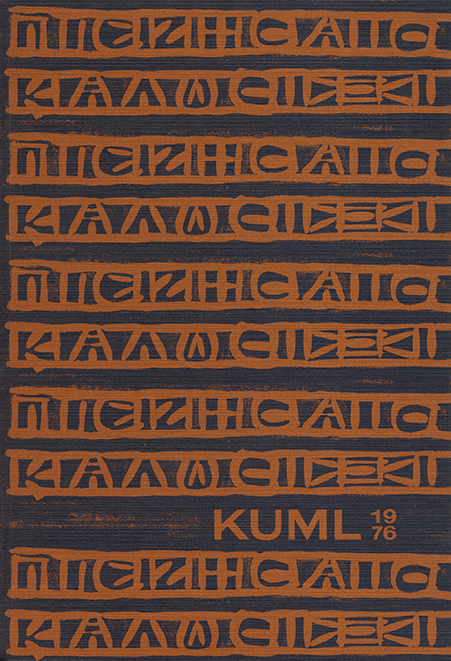A corn hoard from Sarup. A contribution to the agriculture of the TRB culture
DOI:
https://doi.org/10.7146/kuml.v25i25.106622Keywords:
corn hoard, funnel beaker culture, early neolithic, middle neolithic, Sarup, fuchsberg, brændt korn, carbonized corn, emmerAbstract
A corn-hoard from Sarup. A contribution to the agriculture of the TRB Culture.
During excavation of the Sarup camp in south-west Funen a large, entire funnel beaker (vessel a) was found containing a smaller, also entire, funnel beaker (vessel b). On archaeological evidence the vessels are dated to the transition between Early and Middle Neolithic (EN Period C and MN Period la), also called the Fuchsberg Phase (5).
The two vessels contained carbonized plant material. After washing through a sieve with a 0. 9 mm mesh the amount of plant remains from vessel a was 69.37 g and from vessel b 8.19 g, a total of 77.56 g or 224 cc.
METHOD
Sorting under the microscope showed that most of the plant remains were grains of emmer (Triticum dicoccum), and only a few grains could be assigned to other species. The whole grains were set apart for further treatment. These comprised about 10% of the total carbonized plant material in vessel a and about 20% in vessel b, or 8.93 g in all. All spikelet forks and other seeds and fruits, with fungal sclerotia, were also set apart (table 1).
Fragments of grains from vessel a have been C14-dated to 2630±70 B.C. (K-2628, conventional age).
From table 1 it is apparent that the contents of the two vessels are relatively uniform, and it must be assumed that they derive from the same cultivation area (field). The two materials will thus in the following be regarded as a single unit.
The dimensions recorded are shown in fig. 1. The length/breadth index (L/B x 100) and thickness/breadth index (T/B x 100) have been calculated.
DESCRIPTION OF THE CARBONIZED PLANT REMAINS
The material contained the following types of emmer grains (Triticum dicoccum): grains from two-seeded spikelets, underdeveloped grains, grains from one-seeded spikelets and drop-shaped grains (table 2, fig. 2 and 6). Measurements of these are given in table 3 and fig. 3, 4 and 5. Entire spikelets have not been observed, only spikelet forks (fig. 7). Measurements of these are given in fig. 8.
Measurements of einkorn (Triticum monococcum) (fig. 9). club wheat/bread wheat (Triticum aestivum s.1.) and barley (Hordeum vulgare, Nudum) (fig. 10) are given in table 4. Internodes of wheat or barley were not found.
RESULTS
After discussing the finding conditions and the archaeological interpretation of the vessels the result of the research now reported are accounted.
From table 1 it is apparent that 94% of the grains are emmer, while einkorn, club wheat/bread wheat and barley occur in smaller amounts. This suggests a deliberate cultivation of emmer as monoculture. The presence of small amounts of the other types of grain is due either to contamination in the seed or infiltration from neighbouring plots. The weed seeds observed are all well known from present-day cultivated fields. Even considering the fact that the material was sieved before the botanical treatment, it was remarkably uncontaminated. Similar paucity of weeds is known from other finds from the Neolithic and Bronze Age (17). This is explained by the method of harvesting.
The Sarup camp is situated in an area of glacifluvial sand and gravel. A possible connection between the soil and the high amonts of underdeveloped grains and grains from one-seeded spikelets is suggested.
FUNNEL BEAKER AGRICULTURE IN DENMARK
Table 5 records the occurrence of corn impressions in pots and of carbonized grains from investigated localities in Denmark. The Sarup find gives with its greater statistical certainty the best picture so far of corn cultivation of the time.
Agriculture is illustrated palynologically with the occurrence of emmer, einkorn and barley. Emmer seems to be the most common pollen grain (25). The cultivation phase itself and its consequences for the flora have been described as the so-called land occupation (26). It has not yet been possible to link this to definite periods of the funnel Beaker culture.
At the present stage it may be established that the grain types emmer, einkorn, club wheat/bread wheat and naked and hulled six-row barley have been cultivated. Emmer has predominated; naked barley has been more important than hulled. The Sarup find makes an important contribution to our knowledge of corn cultivation. Finds from Early and Middle Neolithic in Sweden seem to show a dominance of emmer and einkorn at certain settlements, while naked barley and club wheat/bread wheat are more common in other finds (27), but these suppositions pall build on identification of imprints. Further large finds of carbonized grains in Denmark may well reveal a more differentiated cultivation in the course of the over 1200 years of Funnel Beaker culture.
Grethe Jørgensen
Keywords: corn hoard;kornfund;korndepot;tragtbægerkultur;funnel beaker culture;early neolithic;middle neolithic;tidlig neolitikum;mellem neolitikum;Sarup;fuchsberg;brændt korn;carbonized corn;emmer
Downloads
Published
How to Cite
Issue
Section
License
Fra og med årgang 2022 er artikler udgivet i Kuml med en licens fra Creative Commons (CC BY-NC-SA 4.0).
Alle tidligere årgange af tidsskriftet er ikke udgivet med en licens fra Creative Commons.


